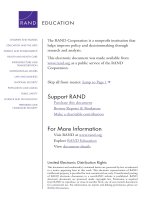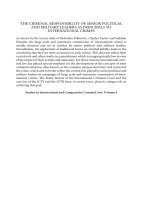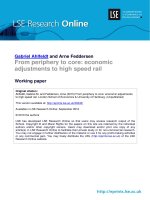Kidney and Blood Pressure Regulation - Contributions to Nephrology Vol. 143 pptx
Bạn đang xem bản rút gọn của tài liệu. Xem và tải ngay bản đầy đủ của tài liệu tại đây (2.39 MB, 177 trang )
Kidney and Blood Pressure Regulation
Contributions to Nephrology
Vol. 143
Series Editor
Claudio Ronco
Vicenza
Kidney and Blood
Pressure Regulation
Basel · Freiburg · Paris · London · New York ·
Bangalore · Bangkok · Singapore · Tokyo · Sydney
Volume Editors
Hiromichi Suzuki Saitama
Takao Saruta
Tokyo
37 figures and 8 tables, 2004
Hiromichi Suzuki Takao Saruta
Department of Nephrology and Department of Internal Medicine
Kidney Disease Center School of Medicine
Saitama Medical School Keio University
Saitama (Japan) Tokyo (Japan)
Bibliographic Indices. This publication is listed in bibliographic services, including Current Contents
®
and
Index Medicus.
Drug Dosage. The authors and the publisher have exerted every effort to ensure that drug selection and
dosage set forth in this text are in accord with current recommendations and practice at the time of publication.
However, in view of ongoing research, changes in government regulations, and the constant flow of information
relating to drug therapy and drug reactions, the reader is urged to check the package insert for each drug for
any change in indications and dosage and for added warnings and precautions. This is particularly important
when the recommended agent is a new and/or infrequently employed drug.
All rights reserved. No part of this publication may be translated into other languages, reproduced or
utilized in any form or by any means electronic or mechanical, including photocopying, recording, microcopying,
or by any information storage and retrieval system, without permission in writing from the publisher.
© Copyright 2004 by S. Karger AG, P.O. Box, CH–4009 Basel (Switzerland)
www.karger.com
Printed in Switzerland on acid-free paper by Reinhardt Druck, Basel
ISSN 0302–5144
ISBN 3–8055–7751–6
Library of Congress Cataloging-in-Publication Data
A catalog record for this title is available from the Library of Congress
Contributions to Nephrology
(Founded 1975 by Geoffrey M. Berlyne)
V
Contents
VII Preface
Suzuki, H. (Saitama); Saruta, T. (Tokyo)
1 An Overview of Blood Pressure Regulation Associated
with the Kidney
Suzuki, H. (Saitama); Saruta, T. (Tokyo)
16 Salt, Blood Pressure, and Kidney
Fujita, T.; Ando, K. (Tokyo)
32 Involvement of Renal Sympathetic Nerve in Pathogenesis of
Hypertension
Kumagai, H.; Onami, T.; Iigaya, K.; Takimoto, C.; Imai, M.;
Matsuura, T.; Sakata, K.; Oshima, N.; Hayashi, K.; Saruta, T. (Tokyo)
46 Blood Pressure Regulation and Renal Microcirculation
Takenaka, T.; Hayashi, K.; Ikenaga, H. (Saitama)
65 Role of Renal Eicosanoids in the Control of Intraglomerular
and Systemic Blood Pressure during Development
of Hypertension
Arima, S.; Ito, S. (Sendai)
77 Novel Aspects of the Renal Renin-Angiotensin System:
Angiotensin-(1–7),ACE2 and Blood Pressure Regulation
Chappell, M.C. (Winston-Salem, N.C.); Modrall, J.G. (Dallas, Tex.);
Diz, D.I.; Ferrario, C.M. (Winston-Salem, N.C.)
90 Role of Aldosterone Blockade in the Management
of Hypertension and Cardiovascular Disease
Epstein, M. (Miami, Fla.)
105 Clinical Implications of Blockade of the Renin-Angiotensin
System in Management of Hypertension
Chua, D.Y.; Bakris, G.L. (Chicago, Ill.)
117 Renal Renin-Angiotensin System
Ichihara, A. (Tokyo); Kobori, H. (New Orleans, La.);
Nishiyama, A. (Kagawa); Navar, L.G. (New Orleans, La.)
131 Kidney and Blood Pressure Regulation
Kalil, R.S.; Hunsicker, L.G. (Iowa City, Iowa)
145 Clinical Strategy for the Treatment of Hypertension
in Non-Diabetic and Diabetic Nephropathy in Japan
Kanno, Y.; Okada, H.; Nakamoto, H.; Suzuki, H. (Saitama)
159 Angiotensin Type 1 Receptor Blockers in
Chronic Kidney Disease
Suzuki, H. (Saitama)
167 Author Index
168 Subject Index
Contents VI
Preface
This book attempts to integrate the progress in the physiological aspects of
blood pressure regulation mechanisms related to the kidney. With this in mind,
we tried to collect a series of original contributions from leading experts in the
field. The continuous evolution of techniques and biomedical aspects has over-
all led to significant progress; however, in recent years, major concerns have
been expressed about gene target research. Therefore, molecules of different
origin and nature are investigated from various aspects and a number of particles
are hardly integrated. In contrast to these developments in molecular biology,
many large-scale clinical trials investigating the effects of antihypertensive
drugs on cardiovascular events have been and are at present being carried out,
and these results are not always consistent. Between these two extremes – gene-
targeted science and large-scale clinical trials – the exact mechanisms behind
the pathophysiological process of renal disease have been investigated. It is
likely that a combination of metabolic and hemodynamic abnormalities explain
the progression of renal diseases. Clearly, mechanisms related to the response
to blood pressure elevation are important as is the possibility that the metabolic
and hemodynamic pathway is inhibited. This has been a greater challenge than
we originally envisaged, not least of all because there has recently been an
explosion of interest in blood pressure regulation in the kidney. This challenge
has been admirably met by the international panel of authors who agreed to
contribute to this book. Their contributions are outstanding.
We acknowledge that the wisdom is theirs and the mistakes are ours.
Needless to say, this book does not provide all of the answers to the clinical as
well as basic challenges faced by those specialists who work in this field of
VII
hypertension and the kidney, but we hope it does provide a solid foundation
from which to move forward and tackle one of the most important relations
between blood pressure regulation and the kidney. Obviously, much work still
needs to be done and one of the intentions of this book is to stimulate further
research in this area where so many subdisciplines of medical science are
involved – from the extremes of genetic and molecular biology to clinical and
pharmacological research trials.
We wish to express our appreciation to our many associates and colleagues
who, in their particular fields, have helped us with constructive criticism and
helpful suggestions. This book could not have been produced without the ded-
icated help of our co-workers in the editorial offices of the individual editions.
Finally, we continue to be indebted to the staff of Karger Publishers.
Hiromichi Suzuki
Takao Saruta
Preface VIII
Suzuki H, Saruta T (eds): Kidney and Blood Pressure Regulation.
Contrib Nephrol. Basel, Karger, 2004, vol 143, pp 1–15
An Overview of Blood
Pressure Regulation Associated
with the Kidney
Hiromichi Suzuki
a
, Takao Saruta
b
a
Department of Nephrology, Saitama Medical School,
Moroyama-machi, Saitama and
b
Department of Internal Medicine,
School of Medicine, Keio University, Tokyo, Japan
The kidney is involved in the maintenance of peripheral vascular resistance
through the action of angiotensin II (Ang II), which is the final product of the
renin-angiotensin system (RAS) and participates in the volume control of cardiac
output by regulating urinary salt and water excretion. Since it is well known that
arterial pressure is equal to cardiac output multiplied by total peripheral resist-
ance, the kidney is indispensable for regulation of blood pressure. When the
blood pressure rises above normal, the kidneys excrete increased quantities of
fluid, and progressive loss of this fluid causes blood pressure to return toward
normal. Conversely, when the blood pressure falls below normal, the kidneys
retain fluid, and the pressure normalized. Neurohormonal and possibly other
factors limit urine sodium excretion, thereby expanding extracellular fluid vol-
ume or requiring higher renal perfusion pressure to permit sodium excretion
adequate to prevent extracellular volume expansion. When the kidney is injured
by any cause, it leads to a physiological changes that are responsible for pro-
gressive hypertensive renal diseases [1]. For example, patients with a strong
family history of hypertension who undergo heminephrectomy for any reason
become hypertensive [2].
The key factor is the regulation of renin. Excess of sodium intake
decreases renin synthesis and secretion in the juxtaglomerular cells, and con-
versely, reduction of sodium intake increases renin synthesis and secretion.
Blood volume and cardiac output are affected by the vasoconstrictor substance,
Ang II, which is derived from angiotensin I (Ang I) by the action of angiotensin-
converting enzyme (ACE); this occurs mainly in the lungs where circulating
Suzuki/Saruta 2
Ang I is converted to the active, 8-amino-acid Ang II. Ang II is one the
most potent renal vasoconstrictors, as well as a potent regulator of circulatory
volume.
To delineate the role of kidney in the control mechanism of blood pressure,
we describe three major mechanisms that are involved, namely, renal blood flow
(RBF), sympathetic nerve system, and pressure-natriuresis control (illustrated
in figure 1). Blood pressure regulation in the kidney involves the interplay of
these factors.
RBF receives 25% of cardiac output and the normal kidney adjusts its
vascular resistance so that the RBF is kept nearly constant over a wide range of
perfusion pressures. This ability is maintained in hypertensive animals, although
the RBF autoregulation is adjusted to higher perfusion pressure levels. In hyper-
tension, as well as in congestive heart failure, the RBF is kept constant by an
autoregulatory mechanism in spite of a reduction in cardiac output, thus main-
taining adequate levels of glomerular filtration rate (GFR). There are two
components to the autoregulation of RBF, the myogenic response of the affer-
ent arteriole and the tubuloglomerular feedback by the juxtaglomerular appara-
tus (JGA).
Given the powerful influence of changes in renal hemodynamics
(i.e., blood pressure, GFR and RBF) on urinary sodium excretion, it is evident
that the influence of changes in renal sympathetic nerve activity (RSNA) on
urinary excretion of sodium remains constant. By using electrical stimulation
of the efferent renal sympathetic nerves at threshold frequencies that result in
a decreases in RBF, a reversible decrease in urinary sodium excretion occurred
Pressure
natriuresis
Renal sympathetic
nerve
Vasoactive substance
JG
cells
Afferent
artery
Distal
tubules
Efferent
artery
Mesangium
cells
Renal blood
flow
Fig. 1. Three major mechanisms that are involved, namely, renal blood flow, sympa-
thetic nerve system, and pressure-natriuresis control.
An Overview of Blood Pressure Regulation Associated with the Kidney 3
in the absence of changes in GFR, RBF and blood pressure, indicating that low-
frequency renal sympathetic nerve stimulation increased overall renal tubular
sodium reabsorption via a direct action on the renal tubule, independent of
changes in renal hemodynamics. In a series of studies, it was found that the
effects of RSNA on renin secretion from the JGA were graded with respect to
the intensity of the RSNA that interacted with other mechanisms of renin secre-
tion, i.e., the renal arterial baroreceptors through the effects of RBF and the
renal tubular macular densa receptors through the amounts of urinary sodium
excretion [3].
Pressure natriuresis refers to the effect of increased arterial pressure that
leads to an increase renal sodium excretion, an effect that becomes especially
powerful with long-term changes in blood pressure. The mechanisms of pres-
sure natriuresis continue to operate until blood pressure returns to the initial set
point, which is determined by multiple factors that influence renal excretory
ability. When the RAS is fully functional, the long-term relation between arte-
rial pressure and sodium excretion is extremely steep, so that minimal changes
in blood pressure are needed to maintain sodium balance over a wide range of
sodium intakes. Conversely, changes in activity of the RAS have a major influ-
ence on renal-pressure natriuresis, and the inability to adjust the activity of this
system appropriately makes pressure natriuresis less effective [4].
As noted above, all mechanisms closely relate with the RAS. With these
under consideration, we would like to view the JGA as the center of regulation
of blood pressure in the kidney and/or the human body (illustrated in figure 2).
Renin is secreted from the JGA via the macula densa. As physical stimulants,
both pressure and flow mediate renin synthesis and secretion [5]. As chemical
factors, inorganic and organic compounds stimulate renin synthesis and secretion.
For example, Cl ion (inorganic stimulants) is shown to be a mediator of renin
secretion. Moreover, as a biophysical stimulant, the role of renal sympathetic
nervous stimulation might be important for regulation of renin secretion.
Kurokawa [6] noted in his review that Cl ions are essential for regulation
of JGA and/or TGF. He introduced the studies by Holstein-Rathlou [7] who,
using a Cl ion-sensitive microelectrode, revealed the presence of fairly regular
oscillations at about 20 cycles/s in the distal tubular fluid Cl ion just beyond the
macula densa, and of the proximal intratubular pressure, a reflection of single
nephron GFR.
Chloride ions play an important role in the regulation of JGA as
does the relationship between RSNA and JGA. The quantitative relationships
are (1) substantial stimulation of JGA and antinatriuresis can occur with lev-
els of RSNA that do not affect GFR and renal vascular resistance and (2) lev-
els of RSNA that decrease RBF and GFR will stimulate JGA and produce
antinatriuresis.
Suzuki/Saruta 4
These regulator mechanisms of JGA prompted the examination of patho-
physiological conditions in which it had been long suspected that increased
RSNA and RBF played an important role in antinatriuresis and/or influenced
the function of the JGA. These regulatory mechanisms are normally autoregu-
lated under the control of neuro- and hormonal factors, such as Ang II, norepi-
nephrine, vasopressin, etc. Among these factors, the RAS is the most important
system for renal regulatory mechanisms of blood pressure. A growing body of
evidence suggests that Ang II is involved in regulation of RBF, RSNA, pressure
natriuresis and intraglomerular pressure feedback system, etc. These effects
involve conversion of angiotensinogen (substrate) to Ang I by renin (enzyme)
and subsequent conversion of Ang I to Ang II by ACE. Hypertension and con-
gestive heart failure are important examples where this system plays a role. In
focusing on these processes, our group has been investigating the complex
pathophysiological processes. In this article, we have reviewed mainly the work
Glomerulus
Renal sympathetic nerve
Biophysical signals
Tubulus
Hemodynamic
signals
Renin ϩ
Angiotensinogen
⇒ Angiotensin I
Angiotensin-II
converting
enzyme
Angiotensin
II
Endothelial
cells
Vascular
Adrenals
Central
nervous
system
Inorganic
signals
Na
ϩ
or
Cl
Ϫ
Organic signals
Fig. 2. View of the juxtaglomerular apparatus as the center of regulation of blood
pressure in the kidney and/or the human body.
An Overview of Blood Pressure Regulation Associated with the Kidney 5
from our group; however, we acknowledge and recognize that many investiga-
tors in this field have made important contributions to understanding the mech-
anism of blood pressure regulation by the kidney.
Studies in Hypertension
Although there are many factors involved in the etiology of hypertension
[8–15], the important role of the kidney in regulation of volume and vascular
resistance makes it a prime suspect as a mediator of hypertension. Neurohumoral
and possible other factors limit urinary sodium excretion, thereby expanding
extracellular fluid volume or requiring higher renal perfusion pressure to permit
adequate sodium excretion to prevent extracellular fluid volume expansion. Early
studies of Bianchi et al. [16] and more definite well-controlled experimental
studies of Rettig et al. [17] showed that ‘blood pressure goes with the kidney’.
Transplantation of the kidney from a genetically hypertension-prone donor rat,
even when it had been kept normotensive from weaning by antihypertensive
medications, caused progressive increase of blood pressure in a recipient animal,
which was immunologically manipulated to prevent a rejection reaction. Also,
human renal transplant studies showed that there is a genetic component asso-
ciated with the renal factors that mediate hypertension. Thus, previously nor-
motensive renal transplant recipients without a family history of hypertension,
who receive a kidney from a donor with a family history of hypertension,
develop hypertension more frequently and require more medication for blood
pressure control compared to those patients who receive a kidney from a donor
without a family history of hypertension [18]. To investigate more precise mech-
anisms of hypertension and the effects of antihypertensive medications on the
regulatory factors such as RSNA, RBF, and pressure natriuresis, animal models
of hypertension have been used.
Spontaneously Hypertensive Rats (SHR)
Various pathophysiological aspects of hypertension have been investigated
using the SHR model.
The pressure-natriuresis mechanism is known to be impaired in SHR, and
some studies have suggested an inadequate adaptation of the RAS to salt loading;
however, no decisive evidence has been presented until recently. Takenaka et al.
[19] compared the pressure-natriuresis response curves of SHR and Wistar-
Kyoto (WKY) rats. The pressure-natriuresis relationship curve in SHR was
shifted toward higher pressure in comparison to WKY rats. The inhibition of
intrarenal RAS by MK-422 (ACE inhibitor) in SHR resulted in the excretion of
more sodium at a given pressure, whereas no significant changes were observed
Suzuki/Saruta 6
in WKY rats which showed significant changes in blood pressure, indicating
that intrarenal RAS might be important for pressure-natriuresis mechanisms in
SHR. Moreover, in SHR, administration of a kinin antagonist did not affect the
recovered pressure-natriuresis relationship during intrarenal RAS inhibition
with an ACE inhibitor. Similarly, administration of an angiotensin antagonist
produced an increased sodium excretion accompanied by an increase in renal
plasma flow. Conversely, administration of Ang I to WKY rats produced anti-
natriuretic effects without any significant changes in renal hemodynamics.
Following this work, Ikenaga et al. [20] clarified the role of nitric oxide (NO)
in pressure natriureis in SHR. NO is well known as an important modulator of
blood pressure and renal function [21–23]. They demonstrated that inhibition of
NO synthesis using L-N
G
-monomethyl-L-arginine (L-NMMA) markedly low-
ered the slope of the pressure-natriuresis curve of WKY, while L-arginine
administration improved that of SHR. These effects on the pressure-natriuresis
response are considered to be mediated by NO, because they were effectively
reversed by the concomitant infusion of L-NMMA and L-arginine. In all cases,
there were no changes in the GFR, indicating that there was no filtered sodium
load on the glomeruli. It has been suggested that suppression of tubular sodium
reabsorption due to interstitial hydrostatic pressure elevation is essential to the
mechanism of pressure-natriuresis response, and that papillary hemodynamics
play a critical role in the regulation of the interstitial hydrostatic pressure. These
findings prompt us to propose the hypothesis that NO participates in the pressure-
natriuresis response through regulation of intrarenal blood flow distribution.
Moreover, the deficiency in NO system might be one of the responsible factors
for the impaired pressure natriuresis in SHR. Based on their studies, it was
proposed that deficiency in NO and activation of the RAS system produced
impaired pressure natriuresis in living animals as well as humans. From these
studies, it is clear that NO plays an important role in regulation of blood pres-
sure in the kidney. Kumagai et al. [24] examined the role of NO in relation to
RBF and the sympathetic nervous system using conscious rabbits. In renal
innervated rabbits, L-arginine increased RBF and decreased RSNA. In contrast,
no changes occurred in any variable during D-arginine infusion. L-NMMA
attenuated the RBF and RSNA responses to L-arginine. In renal denervated rab-
bits, L-NMMA also attenuated the RBF response to L-arginine and abolished
these responses but not in those of renal innervated rabbits. These findings indi-
cate that exogenous L-arginine elicits a reduction in RSNA and that the reduction
in RSNA could contribute to the increase in RBF as well as other mechanisms
such as a direct vasodilator action of NO on vascular smooth muscle tone. In
parallel with these studies, Jimbo et al. [25] examined a possible role of NO in
modulating sympathetic nerve activity through its action on baroreceptor reflex
arc. L-Arginine infusion decreased blood pressure, aortic, cervical, and renal
An Overview of Blood Pressure Regulation Associated with the Kidney 7
nerve activity without significant changes in heart rate. L-NMMA infusion
increased blood pressure and aortic nerve activity and decreased heart rate, while
it tended to increase cervical and renal nerve activity which was not statistically
significant. From these results, it may be inferred that NO modulates efferent
sympathetic nerve activity, not by altering the afferent or efferent limbs of the
baroreceptor reflex arc, but by interacting with the sympathetic pathways in the
central nervous system. Moreover, considering Ikenaga’s study, it is suggested
that the renal circulation is especially sensitive to NO formation.
We also examined the effects of antihypertensive drugs on baroreceptor
reflexes in SHR. Evidence from other studies suggests that an arterial barore-
ceptor reflex mechanism modifies regional blood flow and that the effectiveness
of the baroreceptor reflex mechanisms would be very limited if the resetting
process is not reversible. Restoration of baroreceptor reflex function (i.e. nor-
malization of reflex sensitivity and reversibility of baroreceptor resetting) is
important in preserving internal organ function since it may alleviate the risk of
decreasing regional blood flow. Kumagai et al. [26, 27] reported two remark-
able findings. First, that a possible critical phase sensitive to intervention with
antihypertensive treatment exists during the development of hypertension.
Secondly, as expected, the effects of four different class of antihypertensive
agents, namely, a diuretic, an ACE inhibitor, a -blocker, and a calcium antag-
onist on baroreceptor reflex, calculated by using the relation between RSNA
and mean blood pressure, were similar when these drugs were used early in the
treatment of hypertension. In this experiment, attenuation of the development
of hypertension is responsible for the restoration of impaired baroreceptor
reflex control of RSNA and heart rate. In contrast to these findings, the late start
of treatment with calcium antagonist or ACE inhibitor, but not a diuretic agent
or -blocker, moderately improved the RSNA gain, whereas only the calcium
antagonist slightly improved the heart rate gain. In addition, none of the four
agents with a late start of treatment improved the range of reflex sympathetic
excitation. These studies clearly demonstrated that in SHR modulation of barore-
ceptor reflex depends on blood pressure control, if cardiovascular remodeling
and vessel distensibility were not fully developed.
In parallel with the findings of Kumagai et al. [26, 27], Ichikawa et al.
[28, 29] found that the responses of the afferent part of the baroreceptor to anti-
hypertensive treatment were also impaired in SHR. In untreated SHR, the cor-
relation curve of arterial pressure and aortic nerve activity was shifted to the
right, that is, to a higher pressure level, and the maximum gain was depressed
compared with untreated WKY rats. An equivalent decrease in arterial pressure
with the four different antihypertensive drugs produced a leftward shift of the
arterial pressure-aortic nerve activity correlation curve to a similar extent in
SHR. From these findings it can be inferred that antihypertensive treatment
Suzuki/Saruta 8
with the four different classes of agents equally enhances the arterial barore-
ceptor function through blood pressure reduction but not through specific
depressor mechanisms at the early stage of hypertension. Ichikawa et al. [30]
also examined the effects of long-term treatment with the four different classes
of antihypertensive drugs on aortic baroreceptor activity in SHR with chronic
hypertension. They found that (1) the four drugs induced baroreceptor resetting
to a lower pressure level and that (2) baroreceptor sensitivity is augmented more
by the calcium antagonist or the ACE inhibitor than by the diuretic agent or the
-blocker. These findings might be explained as follows: chronic hypertension
induces changes in the aortic medial layers (such as smooth muscle hypertrophy
and increased collagen content) that affect baroreceptor sensitivity through
changes in vessel distensibility and/or mechanical coupling of the baroreceptors
to the vessel. Calcium blockers and ACE inhibitors have been shown to prevent
these medial changes to a greater extent than diuretics and -blockers, probably
by acting directly on vascular smooth muscle. These beneficial effects on the
aortic media may contribute to the preserved baroreceptor sensitivity.
Dahl Salt-Sensitive Rats
In Dahl salt-sensitive (DS) rats, elevation of blood pressure has been
shown to result from salt loading and renal transplantation from DS rats to Dahl
salt-resistant (DR) rats is able to elevate the recipient’s blood pressure. In DS
rats, the pressure-natriuresis relationship is blunted compared to that of DR rats.
These findings implicated an intrinsic defect in the kidney of DS rats.
Takenaka et al. [31] examined the role of prostaglandins on pressure natri-
uresis in DS rats. When DS rats are untreated, the pressure-natriuresis curve is
blunted and secretion of prostaglandin E
2
is decreased in comparison to the DR
rats. Treatment with indomethacin blunted the pressure-natriuresis curve in the
DR rats, while no significant changes were observed in the DS rats. This study
suggested that a decrease in renal prostaglandins plays some role in blunting of
pressure natriuresis in DS rats.
Influence of Sex on Hypertension
Cardiovascular events due to hypertension differ between men and women.
Moreover, the prevalence of hypertension is twice higher in postmenopausal
women than in premenopausal women.
Increased sodium reabsorption by the kidney has been suggested to be a
factor in this. Tominaga et al. [32] reported that decreases in sex hormones and
increases in sodium sensitivity are important factors in the genesis of post-
menopausal hypertension. Otsuka and Sasaki [33–35] investigated the effect of
ovariectomy on pressure natriuresis in DS rats. The impaired pressure-natriuresis
response of DS rats was further blunted by ovariectomy and that of DR rats was
An Overview of Blood Pressure Regulation Associated with the Kidney 9
not. The ovariectomized DS rats developed hypertension by salt loading earlier
than sham-operated DS rats. This study indicated that ovariectomy enhances
genetic salt sensitivity by blunting the pressure-natriuresis response, which
precedes the development of overt hypertension in female DS rats.
Renovascular Hypertension
Since an animal model of renal hypertension was first produced by
Goldblatt, renal hypertensive animal models have been used for investigation
mainly focused on pathophysiological role of the RAS [36]. Nakamoto et al. [37]
examined the effects of long-term oral administration of either L-arginine or the
NO synthesis inhibitor, N-nitro-L-arginine on systemic and renal hemodynam-
ics in dogs with chronic two-kidney, one-clip renovascular hypertension. Their
study demonstrated that chronic inhibition of NO synthesis exacerbated reno-
vascular hypertension in dogs. Furthermore, suppression of NO was associated
with blunted activation of the circulating RAS during the evolution of renovas-
cular hypertension. The ischemic kidney showed a greater depression of RBF
and GFR in the presence of NO inhibition. This was associated with a signifi-
cant reduction in RBF but not in GFR of the contralateral untouched kidney. In
contrast, oral administration of L-arginine did not modify the magnitude of the
hypertension produced by renal artery constriction, but it did have a beneficial
effect on the residual function of the ischemic kidney. These findings led to the
conclusion that NO provides a basic vasodilator tone that limits vasoconstrictor
activity of the RAS during the evolution of renovascular hypertension. Again,
the findings indicate that the balance between NO production and the activation
of the RAS is critical for regulation and evolution of hypertension.
In clinical practice, there is still controversial whether calcium antagonists
or ACE inhibitors are superior to protect end-organ damage due to hypertension.
A number of studies examining the effects of these drugs on systemic and renal
hemodynamics have been presented. However, very few studies comparing the
effects of these two classes of hypertensive drugs on RSNA in hypertensive
animals have been conducted. Kumagai et al. [38, 39] examined the different
effects of an ACE inhibitor and a calcium antagonist on RBF and RSNA using
two-kidney, one-clip renal hypertension in rabbits. First, the baroreflex control
of RSNA and heart rate (HR) before and after reduction of blood pressure (BP)
was similar in magnitude with an ACE inhibitor and a calcium antagonist. The
maximum slopes of the curves relating BP to RSNA and HR in renovascular
hypertension were significantly smaller than those in normotensive animals. In
renovascular hypertensive animals, the maximum slope of BP-RSNA response
curve was increased with ACE inhibitor compared with vehicle. In contrast,
the maximum slope of BP-HR response curve was increased with the calcium
antagonist compared with vehicle. These data indicate that in renovascular
Suzuki/Saruta 10
hypertension, the baroreflex control of RSNA and HR are differently regulated
with different classes of antihypertensive drugs. Further study revealed that
these two drugs induced different RBF and RSNA responses. RBF increased
consistently in response to BP reduction with an ACE inhibitor. The increment
was associated with a decrease in plasma concentration of Ang II. In contrast,
RBF decreased significantly after BP reduction with a calcium antagonist. The
calcium antagonist increased the plasma concentration of Ang II and induced
a smaller increase in RSNA than that induced with the ACE inhibitor. This study
suggested that the more complex regulatory mechanisms of RBF and RSNA
under the conditions of elevated BP due to endogenous Ang II.
Deoxycorticosterone Acetate (DOCA) Salt Hypertension
This model is known as a low-renin hypertension model [40–42]. In spite
of many investigations [43], no precise role for ACE inhibitors and Ang II
blockers has been implicated in this model. Using conscious DOCA salt dogs
Naitoh et al. [44] demonstrated that the ACE inhibitors (captopril and imidapri-
lat) produced significant reductions in blood pressure and significant increases
in RBF, GFR, and urinary excretion of sodium, while an AT1 receptor antago-
nist (losartan) caused significant increases only in urinary excretion of sodium
without significant changes in blood pressure, RBF, and GFR. These investiga-
tors performed simultaneous infusion of a bradykinin receptor antagonist and
found that it inhibited the ACE inhibitor induced reduction in blood pressure
and increases in RBF. The results of their studies showed that in low-renin
hypertension, inhibition of Ang II production in the kidney participates in the
natriuretic action of ACE inhibitors. However, hypotensive and other renal
effects are mainly due to the action of bradykinin. These results suggest that
in the kidneys, the effects of ACE inhibitors and Ang II antagonists might be
different.
Neurogenic Hypertension
Besides the hypertensive animal models such as SHR, Dahl rats, renovas-
cular hypertension, etc., that have been studied extensively, another model
namely neurogenic hypertension has been less investigated. Matsukawa et al. [45]
attempted to elucidate the interaction between the SNS and the RAS in neurogenic
hypertension produced by sinoaortic-denervated and norepinephrine-infused
conscious, unrestrained rabbits. They found that in sympathetic-activated ani-
mals postsynaptic interaction between norepinephrine and Ang II is important
in regulation of blood pressure.
Ryuzaki et al. [46, 47], using sinoaortic-denervated rabbits, provided
convincing evidence for association between neurogenic hypertension and the
kidney. They demonstrated that renal nerve stimulation contributed to neurogenic
An Overview of Blood Pressure Regulation Associated with the Kidney 11
hypertension through a combination of elevation of plasma vasopressin as a
result of sinoaortic denervation and renal afferent nerve stimulation.
Glucocorticoid-Induced Hypertension
Both clinical [48] and experimental [49–54] studies clearly demon-
strated that glucocorticoid excess produces elevation of blood pressure; how-
ever, precise renal as well as cardiac hemodynamics had not been clarified until
Nakamoto’s study [55, 56]. He found that administration of a low dose of glu-
cocorticoid did not produce hypertension, while large doses induced elevation
of blood pressure with reduction of cardiac output and markedly increased the
total peripheral resistance. Moreover, he demonstrated that depressor system
such as prostaglandins and bradykinins played an important role in regulation
of blood pressure in this model [57]. From these studies it is suggested that
renal mechanisms are at least in part involved in pathogenesis and regulation of
blood pressure elevation in glucocorticoid excess hypertension.
Studies in Heart Failure
Recent clinical and experimental studies have demonstrated that the block-
ade of the RAS produced an improvement of symptoms and survival rate of
patients with congestive heart failure. We examined the role of vasopressin in
congestive heart failure induced by rapid right ventricular pacing in dogs. In the
dogs with impaired cardiac function, effective RBF and GFR were decreased
mainly due to reduction of cardiac output. In these dogs, plasma renin activity,
norepinephrine and vasopressin were all elevated. Murakami et al. [58] pro-
vided interesting data by studying the dogs with impaired cardiac function.
They compared the acute effects of an ACE inhibitor and an angiotensin type 1
receptor antagonist on cardiac output and RBF. Interestingly, these two types of
drugs showed distinct effects; captopril increased both cardiac output and RBF,
however, losartan increased RBF but failed to alter cardiac output. Furthermore,
Matsumoto et al. [59] found a synergistic action with an ACE inhibitor and a
neuroendopeptidase inhibitor which together produced an improvement of car-
diac output and RBF in dogs with congestive heart failure. The findings of these
studies indicated that in congestive heart failure regulation of cardiac output
and RBF is mutually dependent. Naitoh et al. [60] clearly showed that when the
heart is failing, vasopressin plays an important role with respect to hemody-
namics as well as renal circulation. Combined administration of vasopressin-1
and -2 antagonists produced a marked improvement in cardiac output (ϩ30%) and
renal plasma flow (ϩ50%). Moreover, in dogs with impaired renal function and
reduced GFR (Ϫ15% compared to the normal), vasopressin antagonist improved
Suzuki/Saruta 12
the GFR by 35%. In addition, Okada et al. [61–64] have provided evidence for
the crucial role of vasopressin in hypertensive animals.
Studies in Obesity
The relationship between obesity and hypertension is now widely recog-
nized. Experimental studies have shown that weight gain raises blood pressure
and clinical studies showed that weight loss is effective in lowering blood
pressure in most hypertensive patients. In obesity, a close relationship has been
proposed to exist between impaired natriuresis and increased RSNA and hyper-
tension; however, there have been few studies directly addressing this relation-
ship. Suzuki et al. [65, 66], using a genetically obese rat, Wistar fatty rat, found
that in spite of no apparent impairment of baroreceptor reflex, RSNA was
increased. In addition, without salt loading, blood pressure was not elevated
even though pressure natriuresis was dysregulated. Taken together, obesity-
induced hypertension might be intimately related to salt loading which stimu-
lates RSNA and produces volume in impaired pressure natriuresis.
Conclusions
The syndrome of hypertension is intimately related to kidney function, and
there is good evidence that each can manifest effects in the other. Our current
studies are likely to provide clues for understanding the pathophysiology of
hypertension and heart failure relating to regulatory mechanisms of the kidneys.
References
1 Suzuki H: Treatment of hypertension in chronic renal insufficiency. Intern Med 2000;39:773–777.
2 Ohishi A, Suzuki H, Nakamoto H, et al: Status of patients who underwent uninephrectomy in
adulthood more than 20 years ago. Am J Kidney Dis 1995;26:889–897.
3 DiBona GF: Neural control of the kidney: Past, present and future. Hypertension 2003;41:621–624.
4 Cowley AW Jr: Long-term control of arterial blood pressure. Physiol Rev 1992;72:231–300.
5 Ichihara A, Suzuki H, Miyashita Y, Naitoh M, Hayashi M, Saruta T: Transmural pressure inhibits
prorenin processing in juxtaglomerular cell. Am J Physiol 1999;277:R220–R228.
6 Kurokawa K: Kidney, salt and hypertension: How and why. Kidney Int 1996;(suppl 55):46–51.
7 Holstein-Rathlou NH: Oscillation and chaos in renal blood flow control. Am J Physiol 1990;256:
F1007–F1014.
8 Ohno Y, Matsuo K, Suzuki H, et al: Genetic linkage of the sarco(endo)plasmic reticulum Ca
2ϩ
-
dependent ATPase II gene to intracellular Ca
2ϩ
concentration in the spontaneously hypertensive
rat. Biochem Biophys Res Commun 1996;227:789–973.
9 Ohno Y, Matsuo K, Suzuki H, Tanase H, Takano T, Saruta T: Increased intracellular Ca
2ϩ
is not
coinherited with an inferred major gene locus for hypertension in the spontaneously hypertensive
rat. Am J Hypertens 1997;10:282–288.
An Overview of Blood Pressure Regulation Associated with the Kidney 13
10 Ohno Y, Suzuki H, Matsuo K, Tanase H, Takano T, Saruta T: Augmented Ca
2ϩ
mobilization is a
hypertensive trait discriminated from a ‘major gene’ in backcross analysis between SHR and
Donryu rats. Clin Exp Pharmacol Physiol Suppl 1995;22:S220–S222.
11 Ohno Y, Suzuki H, Yamakawa H, Nakamura M, Kato Y, Saruta T: Correlation of sodium-related
factors with insulin sensitivity in young, lean, male offspring of hypertensive and normotensive
subjects. J Hum Hypertens 2001;15:393–399.
12 Ohno Y, Suzuki H, Yamakawa H, Nakamura M, Otsuka K, Saruta T: Impaired insulin sensitivity
in young, lean normotensive offspring of essential hypertensives: Possible role of disturbed calcium
metabolism. J Hypertens 1993;11:421–426.
13 Ohno Y, Suzuki H, Yamakawa H, Nakamura M, Saruta T: Insulin sensitivity and calcium homeo-
stasis in young, lean, normotensive male subjects. Hypertens Res 2000;23:433–440.
14 Yamakawa H, Suzuki H, Nakamura M, Ohno Y, Saruta T: Role of platelet cytosolic calcium in the
response to salt intake in normotensive subjects. Clin Exp Pharmacol Physiol 1991;18:627–629.
15 Yamakawa H, Suzuki H, Nakamura M, Ohno Y, Saruta T: Disturbed calcium metabolism in offspring
of hypertensive parents. Hypertension 1992;19:528–534.
16 Bianchi G, Fox U, Di Francesco GF, Giovannetti AM, Pagetti D: Blood pressure changes produced
by kidney cross-transplantation between spontaneously hypertensive and normotensive rats. Clin
Sci Mol Med 1974;47:435–448.
17 Rettig R, Folberth C, Strauss H, Kopf D, Waldherr R, Unger T: Hypertension transmitted by
kidneys from stroke-prone spontaneously hypertensive rats. Am J Physiol 1989;257:F197–F203.
18 Manunta P, Cerutti R, Bernardi L, Stella P, Bianchi G: Renal genetic mechanisms of essential
hypertension. J Nephrol 1997;10:172–178.
19 Takenaka T, Suzuki H, Furukawa T, Ogata Y, Saruta T: Role of intrarenal renin-angiotensin system on
pressure natriuresis in spontaneously hypertensive rats. Clin Exp Hypertens A 1990;12:1377–1394.
20 Ikenaga H, Suzuki H, Ishii N, Itoh H, Saruta T: Role of NO on pressure natriuresis in Wistar-Kyoto
and spontaneously hypertensive rats. Kidney Int 1993;43:205–211.
21 Hishikawa K, Nakaki T, Suzuki H, Saruta T, Kato R: L-Arginine-induced hypotension. Lancet
1991;337:683–684.
22 Murakami M, Suzuki H, Ichihara A, Naitoh M, Nakamoto H, Saruta T: Effects of L-arginine on
systemic and renal haemodynamics in conscious dogs. Clin Sci (Lond) 1991;81:727–732.
23 Hishikawa K, Nakaki T, Tsuda M, et al: Effect of systemic L-arginine administration on hemody-
namics and nitric oxide release in man. Jpn Heart J 1992;33:41–48.
24 Kumagai K, Suzuki H, Ichikawa M, et al: Nitric oxide increases renal blood flow by interacting
with the sympathetic nervous system. Hypertension 1994;24:220–226.
25 Jimbo M, Suzuki H, Ichikawa M, Kumagai K, Nishizawa M, Saruta T: Role of nitric oxide in
regulation of baroreceptor reflex. J Auton Nerv Syst 1994;50:209–219.
26 Kumagai K, Suzuki H, Ryuzaki M, et al: Effects of antihypertensive agents on arterial baroreceptor
reflexes in conscious rats. Hypertension 1992;20:701–709.
27 Kumagai K, Suzuki H, Ichikawa M, et al: Comparison of early and late start of antihypertensive
agents and baroreceptor reflexes. Hypertension 1996;27:209–218.
28 Ichikawa M, Suzuki H, Kumagai K, et al: Effects of antihypertensive agents on baroreceptor
function in early hypertensive rats. Hypertension 1994;24:808–815.
29 Ichikawa M, Suzuki H, Kumagai K, et al: Baroreceptor function is restored by antihypertensive
therapy through lowering of blood pressure in adult SHR. Clin Exp Pharmacol Physiol Suppl
1995;22:S67–S69.
30 Ichikawa M, Suzuki H, Kumagai K, et al: Differential modulation of baroreceptor sensitivity by
long-term antihypertensive treatment. Hypertension 1995;26:425–431.
31 Takenaka T, Suzuki H, Sakamaki Y, Itaya Y, Saruta T: Contribution of prostaglandins to pressure
natriuresis in Dahl salt-sensitive rats. Am J Hypertens 1991;4:489–493.
32 Tominaga T, Suzuki H, Ogata Y, Matsukawa S, Saruta T: The role of sex hormones and sodium
intake in postmenopausal hypertension. J Hum Hypertens 1991;5:495–500.
33 Otsuka K, Suzuki H, Sasaki T, Ishii N, Itoh H, Saruta T: Blunted pressure natriuresis in ovariec-
tomized Dahl-Iwai salt-sensitive rats. Hypertension 1996;27:119–124.
34 Otsuka K, Ohno Y, Sasaki T, et al: Ovariectomy aggravated sodium induced hypertension associated
with altered platelet intracellular Ca
2ϩ
in Dahl rats. Am J Hypertens 1997;10:1396–1403.
Suzuki/Saruta 14
35 Sasaki T, Ohno Y, Otsuka K, Suzawa T, Suzuki H, Saruta T: Oestrogen attenuates the increases in
blood pressure and platelet aggregation in ovariectomized and salt-loaded Dahl salt-sensitive rats.
J Hypertens 2000;18:911–917.
36 Suzuki H, Ferrario CM, Speth RC, Brosnihan KB, Smeby RR, de Silva P: Alterations in plasma
and cerebrospinal fluid norepinephrine and angiotensin II during the development of renal hyper-
tension in conscious dogs. Hypertension 1983;5(suppl I):139–148.
37 Nakamoto H, Ferrario CM, Buckalew VM, Suzuki H: Role of nitric oxide in the evolution of renal
ischemia in two-kidney, one-clip renovascular hypertension. Hypertens Res 1998;21:267–277.
38 Kumagai H, Suzuki H, Matsumura Y, Ryuzaki M, Saruta T: Differential effects of captopril and
nicardipine on baroreflex control of sympathetic nerve activity and heart rate in renal hypertension.
J Hypertens 1992;10:1485–1491.
39 Kumagai H, Suzuki H, Ichikawa M, et al: Different responses of renal blood flow and sympathetic
nerve activity to captopril and nicardipine in conscious renal hypertensive rabbits. J Cardiovasc
Pharmacol 1995;25:57–64.
40 Saruta T, Suzuki H, Takita T, Saito I, Murai M, Tazaki H: Pre-operative evaluation of the prognosis
of hypertension in primary aldosteronism owing to adenoma. Acta Endocrinol (Copenh) 1987;116:
229–234.
41 Shibata H, Suzuki H, Murakami M, Sato A, Saruta T: Angiotensin II type 1 receptor messenger
RNA levels in human blood cells of patients with primary and secondary hypertension: Reference
to renin profile. J Hypertens 1994;12:1275–1284.
42 Suzuki H: Pathophysiology and diagnosis of primary aldosteronism. Biomed Pharmacother 2000;
54(suppl 1):118–123.
43 Itaya Y, Suzuki H, Matsukawa S, Kondo K, Saruta T: Central renin-angiotensin system and the
pathogenesis of DOCA-salt hypertension in rats. Am J Physiol 1986;251:H261–H268.
44 Naitoh M, Suzuki H, Arakawa K, et al: Role of kinin and renal ANG II blockade in acute effects
of ACE inhibitors in low-renin hypertension. Am J Physiol 1997;272:H679–H687.
45 Matsukawa S, Suzuki H, Kumagai H, Itaya Y, Saruta T: Interaction between the sympathetic
nervous system and the renin-angiotensin system in neurogenic hypertension in conscious rabbits.
J Hypertens 1996;4(suppl 6):290–296.
46 Ryuzaki M, Suzuki H, Kumagai K, et al: Role of vasopressin in salt-induced hypertension in
baroreceptor-denervated uninephrectomized rabbits. Hypertension 1991;17:1085–1091.
47 Ryuzaki M, Suzuki H, Kumagai K, et al: Renal nerves contribute to salt-induced hypertension in
sinoaortic-denervated uninephrectomized rabbits. Am J Physiol 1992;262:R733–R737.
48 Saruta T, Suzuki H, Handa M, Igarashi Y, Kondo K, Senba S: Multiple factors contribute to the
pathogenesis of hypertension in Cushing’s syndrome. J Clin Endocrinol Metab 1986;62:275–279.
49 Okuno T, Suzuki H, Saruta T: Dexamethasone hypertension in rats. Clin Exp Hypertens 1981;3:
1075–1086.
50 Suzuki H, Handa M, Kondo K, Saruta T: Role of renin-angiotensin system in glucocorticoid
hypertension in rats. Am J Physiol 1982;243:E48–E51.
51 Handa M, Kondo K, Suzuki H, Saruta T: Urinary prostaglandin E
2
and kallikrein excretion in
glucocorticoid hypertension in rats. Clin Sci (Lond) 1983;65:37–42.
52 Handa M, Kondo K, Suzuki H, Saruta T: Dexamethasone hypertension in rats: Role of prostaglandins
and pressor sensitivity to norepinephrine. Hypertension 1984;6:236–241.
53 Kageyama Y, Suzuki H, Saruta T: Role of glucocorticoid in the development of glycyrrhizin-
induced hypertension. Clin Exp Hypertens 1994;16:761–778.
54 Sato A, Suzuki H, Murakami M, Nakazato Y, Iwaita Y, Saruta T: Glucocorticoid increases
angiotensin II type 1 receptor and its gene expression. Hypertension 1994;23:25–30.
55 Nakamoto H, Suzuki H, Kageyama Y, et al: Characterization of alterations of hemodynamics and
neuroendocrine hormones in dexamethasone-induced hypertension in dogs. Clin Exp Hypertens A
1991;13:587–606.
56 Nakamoto H, Suzuki H, Kageyama Y, Murakami M, Naitoh M, Saruta T: Central nervous system
mediates an antihypertensive property in glucocorticoid hypertension in dogs. J Hypertens 1995;
13:1169–1179.
57 Nakamoto H, Suzuki H, Kageyama Y, et al: Depressor systems contribute to hypertension induced
by glucocorticoid excess in dogs. J Hypertens 1992;10:561–569.
An Overview of Blood Pressure Regulation Associated with the Kidney 15
58 Murakami M, Suzuki H, Naitoh M, et al: Blockade of the renin-angiotensin system in heart failure
in conscious dogs. J Hypertens 1995;13:1405–1412.
59 Matsumoto A, Suzuki H, Naitoh M, Murakami M, Nakamoto H, Saruta T: Effects of neutral
endopeptidase combined with ACE inhibitor on cardio-renal hemodynamics in heart failure with
chronic renal failure in dogs (abstract). Annual Meeting of American Society of Nephrology, 1994.
60 Naitoh M, Suzuki H, Murakami M, et al: Effects of oral AVP receptor antagonists OPC-21268 and
OPC-31260 on congestive heart failure in conscious dogs. Am J Physiol 1994;267:H2245–H2254.
61 Okada H, Suzuki H, Kanno Y, Saruta T: Effects of novel, nonpeptide vasopressin antagonists on
progressive nephrosclerosis in rats. J Cardiovasc Pharmacol 1995;25:847–852.
62 Okada H, Suzuki H, Kanno Y, Saruta T: Evidence for the involvement of vasopressin in the patho-
physiology of adriamycin-induced nephropathy in rats. Nephron 1996;72:667–672.
63 Okada H, Suzuki H, Kanno Y, Yamamura Y, Saruta T: Chronic and selective vasopressin blockade
in spontaneously hypertensive rats. Am J Physiol 1994;267:R1467–R1471.
64 Okada H, Suzuki H, Kanno Y, Yamamura Y, Saruta T: Effects of vasopressin V1 and V2 receptor
antagonists on progressive renal failure in rats. Clin Sci (Lond) 1994;86:399–404.
65 Suzuki H, Ikenaga H, Hayashida T, et al: Sodium balance and hypertension in obese and fatty rats.
Kidney Int Suppl 1996;55:S150–S153.
66 Suzuki H, Nishizawa M, Ichikawa M, et al: Basal sympathetic nerve activity is enhanced with
augmentation of baroreceptor reflex in Wistar fatty rats: A model of obesity-induced NIDDM.
J Hypertens 1999;17:959–964.
Hiromichi Suzuki, MD
Department of Nephrology and Kidney Disease Center, Saitama Medical School
Moroyama-machi, Iruma-gun, Saitama 350-0495 (Japan)
Tel. ϩ81 492 761611, Fax ϩ81 492 957338, E-Mail
Suzuki H, Saruta T (eds): Kidney and Blood Pressure Regulation.
Contrib Nephrol. Basel, Karger, 2004, vol 143, pp 16–31
Salt, Blood Pressure, and Kidney
Toshiro Fujita, Katsuyuki Ando
Department of Nephrology and Endocrinology,
University of Tokyo School of Medicine, Tokyo, Japan
It is widely known that excessive salt intake plays a crucial role in the
development of hypertension in humans as well as animals. Several epidemi-
ological studies have demonstrated that prevalence of hypertension is greater in
people on a higher salt diet. Indeed, the INTERSALT study showed the positive
correlation of the incidence of hypertension to the amount of salt intake among
people in 34 different countries [1]. However, the response of blood pressure
(BP) to salt excess differs among individuals with essential hypertension. In our
previous studies [2, 3], according to the BP response to salt loading, hyper-
tensive patients could be divided into two groups – salt-sensitive and non-salt-
sensitive ones (fig. 1). Not only some essential hypertensives but also the other
young borderline hypertensives exhibited the increased salt sensitivity of BP
[4]. Moreover, there is a significant correlation between the elevation of BP
with salt loading and the reduction of BP with the subsequent treatment of
diuretics, suggesting that the individual response to salt loading and restriction
might be attributable to salt retention and depletion, respectively. Thus, it is a
plausible hypothesis that susceptibility of BP to salt intake depends upon the
ability of the kidney to excrete sodium (Na) in the urine.
Salt Sensitivity of Blood Pressure and
Renal Sodium Excretion
Despite the same amount of salt intake, in our previous study, urinary Na
excretion during the high salt diet was significantly decreased in salt-sensitive
patients as compared with non-salt-sensitive patients (fig. 1); Na retention was
significantly greater in salt-sensitive than non-salt-sensitive patients [2].
Especially, the reduction in urinary Na excretion apparently occurred during the









